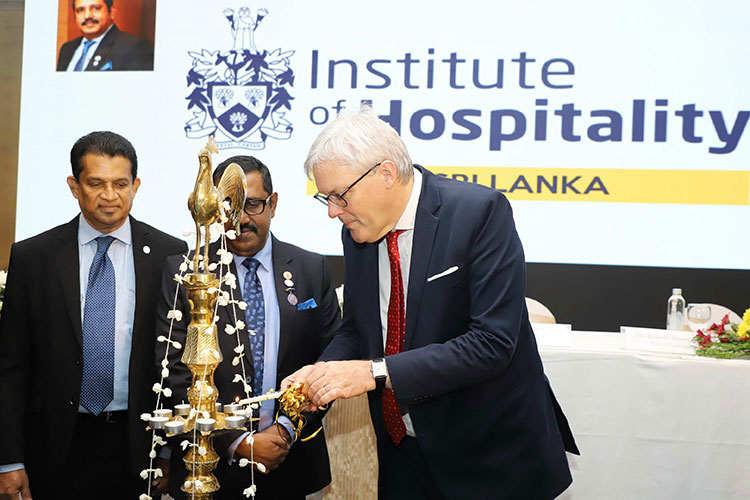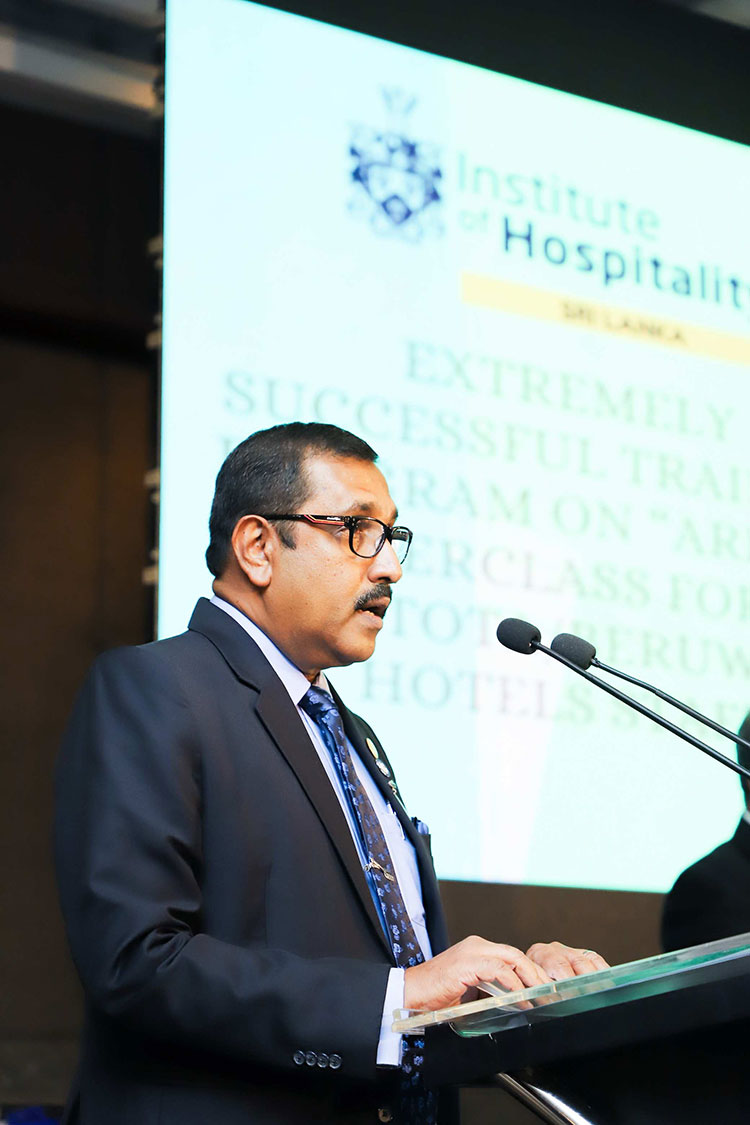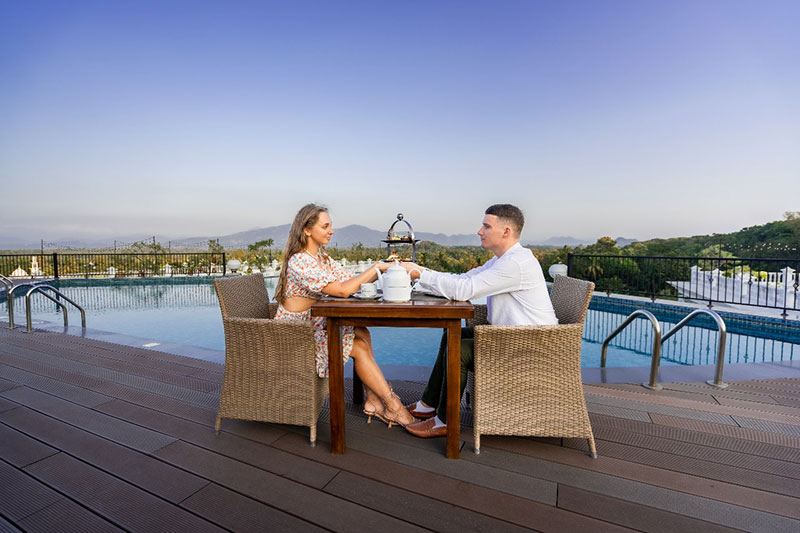Life style
The first ever social club in ceylon and the life of H.A Marshall-its builder
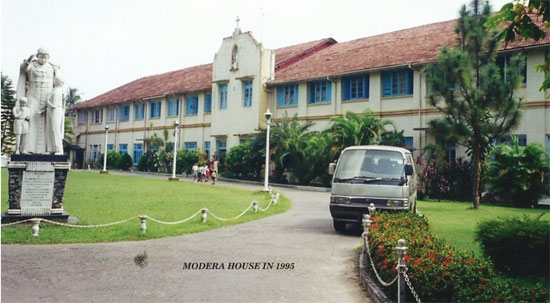
Whist bungalow
by Hugh Karunanayake
When the Portuguese and Dutch occupied the maritime provinces of Ceylon from the 16 th Century to the end of the 18th century, it was more or less a military occupation with the ever present danger of the coastal government being overrun by the monarch who ruled the Kandyan Kingdom. That imminent possibility was mitigated to some degree with the annexation of the maritime provinces by the British East India Co; which occurred during the wars of the French revolution. When the Netherlands came under French control the British made its move to oust the Dutch from Ceylon. The Dutch surrendered the island(or more precisely its maritime areas) to the British in 1796 after some half hearted resistance. In 1802 Ceylon was made a crown colony and it was clear that the British were here to stay. In 1815 the Kandyan Kingdom capitulated to the British through a combination of intrigue, and disaffection in the King’s court rather than military engagement. The doors of the country were now open for British settlement and to exploit the nation’s resources to the advantage of the Metropolitan power.
With Ceylon functioning as a British colony, the stage was set for its administration through a Governor appointed by the monarch in Britain. The administration was done through a Civil Service established by the government and by a legal system largely based on Roman Dutch Law supplemented by laws and customs of the local population. Governor Frederick North arrived in the island on 12 October 1798 accompanied by 9 officials who were to administer the island. Among them were three “officers” Sylvester Gordon, Robert Barry, and George Lusignan, each of them just thirteen years of age!! ( Gives some indication of the confidence of the Brits who thought that even teenagers could keep the”natives” in check) There was also in the group,Henry Augustus Marshall who was appointed First Clerk of the Civil Department which was the precursor to the Treasury. Marshall educated at Charterhouse and Oxford was reputed to be the best classics scholar in the island during his stay. He married the daughter of Colonel Robert Brooke Governor of the Island of St Helena. Mrs Marshall was apparently a wealthy woman as suggested by Governor North commenting on Marshall as “married comfortably”.Mr and Mrs Marshall are said to have been very popular socially and JP Lewis the colonial recorder and historian believed that she was the guardian of the tree referred to on the inscription on the stone tablet seen to this day next to the Wellawatte Bridge on Galle Road. Others have suugested that the Sophia referred to in the inscription is none other than Lady Brownrigg.
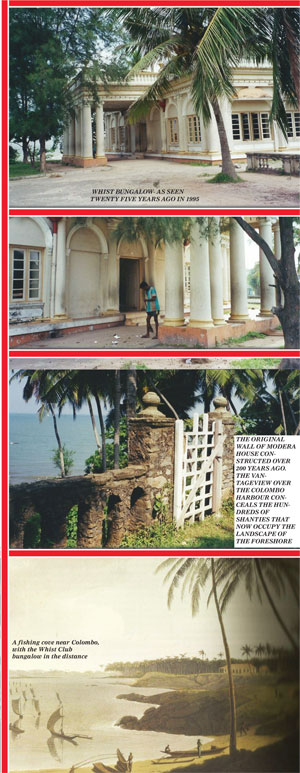 At the time of British rule of the maritime provinces of Ceylon during late 18 th Century, it was the Galle Harbour that was the main point of entry to the island. The Colombo harbour was a tranquil bay used by fishing craft. The areas overlooking the bay of Colombo in the Mutwal area soon became elite residential areas, replacing the Fort and Pettah areas populated by the Dutch. The early British administrators were quick to acquire choice sites for their homes, the best of them overlooking the bay of Colombo. Many stately homes were constructed in the Mutwal, Modera areas. They included the Whist Bungalow, Modera House, Uplands, Elie House, Rock House, all of them located on vantage points overlooking the bay of Colombo. Three of the stately homes, Rock House, Whist Bungalow, and Modera House were built by Henry Augustus Marshall, the Civil Servant, in his private capacity.
At the time of British rule of the maritime provinces of Ceylon during late 18 th Century, it was the Galle Harbour that was the main point of entry to the island. The Colombo harbour was a tranquil bay used by fishing craft. The areas overlooking the bay of Colombo in the Mutwal area soon became elite residential areas, replacing the Fort and Pettah areas populated by the Dutch. The early British administrators were quick to acquire choice sites for their homes, the best of them overlooking the bay of Colombo. Many stately homes were constructed in the Mutwal, Modera areas. They included the Whist Bungalow, Modera House, Uplands, Elie House, Rock House, all of them located on vantage points overlooking the bay of Colombo. Three of the stately homes, Rock House, Whist Bungalow, and Modera House were built by Henry Augustus Marshall, the Civil Servant, in his private capacity.
Rev James Cordiner was appointed Chaplain to the 51 st Foot Regiment in Ceylon at the request of Governor Norh. A man of learning and of perceptive observation Rev Cordiner did a tour round the Island in 1800, which led him to publishing in 1807 one of the earliest English descriptions of the island in a two volume publication titled “A description of Ceylon, with narratives of aTour round the Island in 1800, the expedition to Kandy in 1803, and a visit to Ramessaram in 1804”.
Cordiner observed that “The English society at Colombo is uncommonly pleasant; and an assemblage of so many excellent characters is, certainly rarely to be found. The men at the head of the civil and military departments are particularly amiable: and all ranks live together in a mutual exchange of the most friendly and familiar intercourse….” And “Two weekly clubs which have been established at Colombo for several years past, contribute eminently to the promotion of social pleasures in the settlement. The elder is the Cocoa-nut, or Whist Club, at which the principal amusement is cards. The bungaloe where it is held, is beautifully situated, about four miles north east of Colombo.at the mouth of the Calany-ganga, which there receives the name of Mootwal. The club consists of twelve members, chosen from among the most respectable inhabitants of the place. They give dinners in rotation, and generally invite twelve strangers. Some of the members whose characters are celebrated for extensive hospitality, assemble a still greater number of guests. The entertainment is always liberal, and the assembly never fails to be animated with the highest share of convivial delight.The company repair to the villa about one o’clock in the afternoon, and play cards, read or otherwise enjoy the country, until four when dinner is announced. At half past five, or six o’clock, they rise from the table, make a circuit in their carriages or on horseback, and reach their respective homes before dark.”
What a glorious life the British pioneers would have lived. Little wonder that the aspiring”natives” modelled themselves on the social features of the life of the Brits. The creation of the Whist Club underscored the need for expatriate personnel to engage in social interaction. There were many other venerable institutions to follow in later years like the Colombo Club, Kandy Club, Hill Club all of which offered residential facilities. They were however not open to the local population, who not to be outdone formed their own Orient Club (a natives only residential club). Ethno specific sports clubs followed, and are there to this day eschewing some of the rigid ethno specific admission rules insisted upon at the beginning. Clubs were the order of the day during the nineteenth and twentieth centuries, and the more exclusive the membership the higher the social status that exclusivity conferred! The rise of the new breed of hostelry “the Five Star Hotel” seems to have put paid to all those status symbols and hallmarks of privilege.!
While it is on record that Marshall constructed Whist Bungalow, Modera House, and Rock House there is no evidence to suggest that he ever lived in any of them. The history of occupancy of Whist Bungalow is on the public record. On the closure of the Coca- nut Club, Whist Bungalow was acquired by Sir Richard Morgan, Supreme Court Judge. It was inherited by his son who died suddenly and it was then under the ownership of Mr Louis Peiris and his wife Selina who lived there for many years. The house was featured in the encylopaedic “Twentieth Century Impressions of Ceylon” published in 1907, when it was occupied by the Pieris family. The Famed German Naturalist Ernet Haeckel who visited Ceylon in the 1880s resided in Whist Bungalow and wrote wistfully about his life there in his book “A visit to Ceylon”. The ownership of the house appeared to have changed several times, once even used as a tea store!. The house is presently managed by the National Housing Development authority as a community hall.
The first ever socia…
Members of CSA would be interested to know that the forbears of two senior membesr of the Society once owned Whist Bungalow. Maureen Henricus nee Morgan is a direct descendant of Sir Richard Morgan, while Chandra Senaratne’s maternal grandmother was Mrs Selina Peiris!
Modera House the other creation of Marshall was occupied by the Armitage family, the leading coffee exporters from Ceylon in the nineteenth century. The coffee crash seriously affected the fortunes of the Armitages who sold Modera House to the De La Salle Brothers in the 1880s and moved to Alexandra House, Alexandra Place. The house was later the premises of Alexandra College. Modera House was the location of the film “Elephant Walk” a classic movie of the 1950s. It is now a school run by the De La Salle brothers. “Rock House” built by Marshall was acquired by the government and is Army property for the past over fifty years.
Mr and Mrs Marshall were a popular couple socially. Lieut -Col Campbell in his two volume book “Excursions, adventures, and Field sports in Ceylon” published in 1843 had this to say of the Marshalls ” A gentleman and his lady upon whose hospitality and friendship I had little or no claim, most kindly received me into their charming abode, situated on the sea shore about three miles from Colombo, and it is to the care and attention of Mr and Mrs Marshall that I attribute my temporary recovery.” Famed colonial recorder and writer J Penry Lewis believed that the Marshalls lived near the old toll gate which was in existence at Wellawatte near the bridge over the canal. There was a large banian tree under which a stone tablet was installed praising the virtues of a lady named Sophia. While Mrs Marshall carried her first name as Sophia, it has been suggested that there was another Sophia- viz Lady Sophia Brownrigg the Governor’s wife.
While that riddle remains to be solved, we have to this day the stone tablet with the inscription. It was lying near the entrance to the bicycle shed of the Savoy Cinema, but since has been erected upright near the bridge. Our former President of the Colombo Chapter Somasiri Devendra published a well researched article in his usual scholarly style, which appeared under the title “Wellawatte Inscriptions” in The Ceylankan #9 of Feb 2000. The “younger” club that existed during Marshall’s time, the “Quoit Club” was according to Cordiner situated in an opposite direction to Whist Bungalow, about two miles south of Colombo on the road leading to Point De Galle. Is it possible that Marshall built the Quoit Club as well and also resided there? Could Cordiner have misjudged the distance from Colombo of the Quoit Club ? If such is the case there is more certainty to the speculation that the Wellawatte tablet refers to none other than Sophia Marshall. We are still however lingering in the realm of conjecture !
Henry Augustus Marshall died on 23 January 1841 in his 64 th year and was buried in the old Galle Face Cemetery. A tablet was erected in St Peter’s Church,Fort by his widow and two son “in memory of an elegant classical scholar and a sincere Christian.
Colombo of the eighteenth century was a tranquil place, rich in vegetation, and serene in outlook. It was James Cordiner who observed that: “Nothing about Colombo is more apt to excite admiration than the flourishing state of the vegetable world. So much beauty and variety are in few countries equalled, and nowhere excelled”. Is it a forlorn wish to hope for a revival of Colombo’s lost beauty ? Only time will tell !!
Life style
Camaraderie,reflection and achievements

Institute of Hospitality Sri Lanka
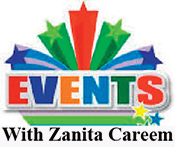 The 32nd Annual General Meeting (AGM) of the UK-based Institute of Hospitality’s Sri Lanka Chapter was held recently at the Ramada Hotel Colombo,.The event provided an evening of camaraderie , reflection of the past and present achievements,setting new benchmarks for the future
The 32nd Annual General Meeting (AGM) of the UK-based Institute of Hospitality’s Sri Lanka Chapter was held recently at the Ramada Hotel Colombo,.The event provided an evening of camaraderie , reflection of the past and present achievements,setting new benchmarks for the future
The AGM had the presence of two distinguished guests, the Chief Guest Opposition Leader Sajith Premadasa, and the Guest of Honour British High Commissioner to Sri Lanka, Andrew Patrick. Their inspiring speeches were lauded by all hoteliers who were present at the occasion
A special thanks was extended to Robert Richardson, CEO of the Institute of Hospitality UK, along with his team, sponsors, committee members, and all attendees for making the event memorable.
Dr. Harsha Jayasingh, Past President of the Institute of Hospitality (UK) Sri Lanka Chapter, emphasised the Institute’s longstanding history and the strength of its Sri Lankan branch. “The Institute of Hospitality (IH) UK has a history of 86 years, and we are proud to be the Sri Lanka Branch. IH Sri Lanka is much stronger now with many members from all areas of the hospitality industry,” he stated.
Dr. Jayasingh highlighted the significant role of tourism in Sri Lanka’s economy,. He said tourism it is the third-largest source of revenue for the country. “Tourism accounts for about 13.3% of total foreign exchange earnings and employs 450,000 people directly and indirectly. The hospitality industry in this island of pearl holds tremendous potential for economic growth, job creations, and cultural exchange,” he added.
He also pointed out more women should be attracted to the industry and advocated for the use of technology in hospitality sector to attract the younger generation.
The newly appointed Chairman Ramesh Dassanayake spoke about the challenges faced by the industry, including the reluctance of youth to join the sector. . Dassanayake expressed concerns over the migration of staff between hotels and the overall ‘brain drain’ in the sector. ” We must maintain high standards in the hotel We must try to attract tourists to Sri Lanka, we must have with many facilities Hence, hotel schools and other professional institutions involved in skills development mustincrease their intakes,” he pointed out.
Chief Guest Sajith Premadasa emphasised the importance of eco tourism and said “We need to have an environmental policy related to tourism in place,” . .
The 32nd AGM of the Institute of Hospitality UK, Sri Lanka Chapter, was a testament to the strength and potential of Sri Lanka’s hospitality industry. The insights and commitments shared during the event set a new benchmark for the future.(ZC)
Pix by Thushara Attapathu
Life style
He recognizes human identity beyond boundaries of gender, race, nationality and religion.
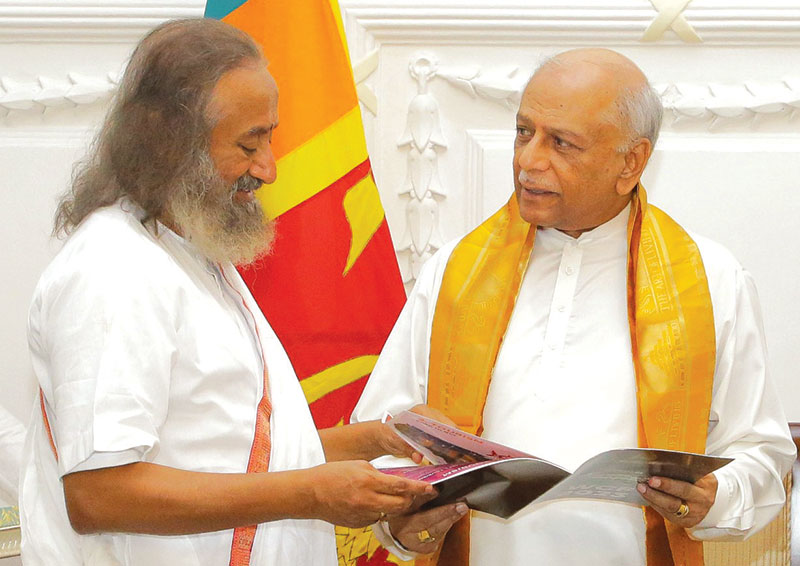
Visit of Sri Gurudev to Sri Lanka
Humanitarian, spiritual leader and Global Ambassador of Peace Gurudev Sri Sri Ravi Shankar (Sri Gurudev) was in Sri Lanka on a three day tour on the invitation of the Prime Minister of Sri Lanka Dinesh Gunewardene. Gurudev who inspired a wave of volunteerism and service to moot one of the largest volunteer-based organisations in the world – The Art of Living – visited the various projects under the aegis of the foundation and launched twelve vocational and technical centers around the island. He was accompanied by thousands of followers from Sri Lanka and around the world.
Gurudev who visited Sri Lanka for the sixth time also had a first day cover launched in honour of his visit. He is a strong proponent of spreading happiness, using the unique Sudarshan Kriya, yoga, meditation and practical wisdom to unite people, empower individuals and transform communities. His programmes provide techniques and tools to live a deeper, more joyous life, while his non-profit organisations recognize the human identity beyond the boundaries of gender, race, nationality and religion.
The Art of Living which has more than 30,000 teachers and over one million volunteers across 180 countries has touched in excess of five hundred million people around the world. CNN called it “Life Changing” and The Washington Post headlined it, “Fresh air to millions”.
In Trincomalee, Gurudev met with war victims and had a heartwarming engagement with the children from the children’s homes run by the Foundation. He also visited the Koneswara Temple in Trincomalee and graced the Kumbhabhishekam at Seetha ecogPnize the human identity beyond the boundaries of gender, race, nationality and religion. Amman temple at Nuwara Eliya. He held discussions with the trustees on the progress of the foundation’s social service projects, while also holding a special event – Ekamuthuwa – attended by a large number of dignitaries and his devotees from around the world.
His time with the Prime Minister was spent discussing the prospects of unity in diversity and uniting Sri Lanka by adding happiness into the formula of living. In addition he had discussions with the Speaker of the Parliament of Sri Lanka Mahinda Yapa Abeywardena, prominent business stewards and civil society leaders.
Life style
Bridal shows with opulence and luxury at The Epitome hotel in Kurunegala
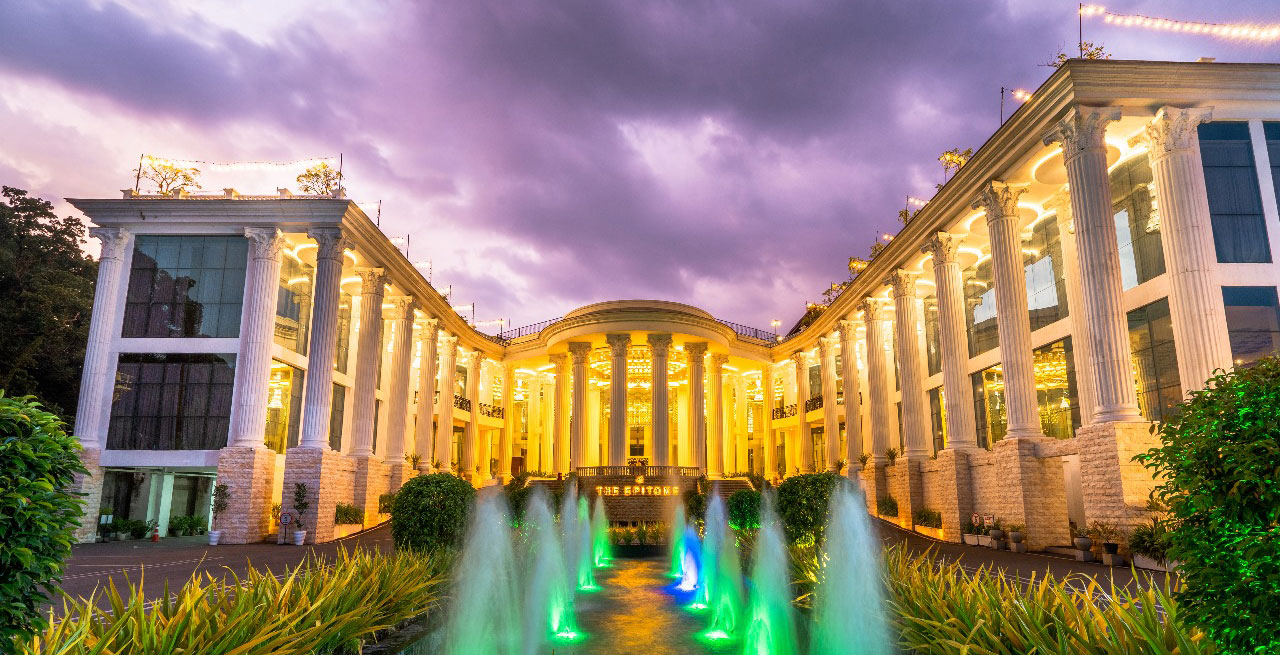
by Zanita Careem
Envison your dream wedding day come to life at the Epitome Hotel, a prestigious city hotel in Kurunegala offering an unrivalled luxury rendors experience for weddings.
The venue is designed to embody opulence and luxury from all quarters for a spectacular wedding in kurunegala,Thier ballroom is the largest banquet facility in Sri Lanka It can be divided into six luxurious pillarless wedding halls on the ground floor and 25pax smaller banquet halls.
It can be easily named as a five star heaven in the heart of the city contributing to a myriad of immense experiences tailored to inspire and delight wedding experiences.
From opulent décor set up to exquisite table decor, lavish food, every detail is meticulously curated to spark your imagination and ignite creativity for a perfect wedding. The previous prestigious wedding shows season one and season two attracted large crowds
were unique events which gave the wedding vendors and potential clients had an opportunity to connect and interact with each other. Beyond being a showcase it was a chance for the wedding vendors to unite and contribute to the vibrancy of the wedding industry. The wedding show covered all area of the bridal industry providing a comprehensive variety of bridal supplies from Sri lanka and became the most popular bridal exhibitions in Kurunegala.This bridal exhibitions allowed brides and grooms to experience first hand the products and services available from suppliers in Sri Lanka
These wedding shows held at The Epitome created a benchmark and gave an opportunity for vendors to create connections to the utmost satisfaction said Harshan Lakshita Executive Director. of the magnificent Hotel
Our wedding shows featured experts and professionals in every field‘ It covered all areas of the bridal industry provided a comprehensive variety of bridal supplies from Sri lanka and became most popular bridal exhibition in this region.We are always open to everyone to join us at our wedding shows in the future. It is an opportunity to discover the incredible talent within our local wedding and bridal vendors to make meaningful relationships and plan thier special day at our breathtaking hotel The Epitome said General Manager Kavinda Caldera
The Epitome Hotel’s bridal show which will be held end of June will buzz with great ideas,advice and inspiration for all those who plan thier dream wedding
…….
The Hotel Epitome’s Wedding Season 3 will marked excellence, celebration and inspiration for those in the wedding industry. The exhibition halls will resonate with ideas on exquisite bridal wear to decor, florists , photography etc and showshowcase the rich tapestry of talent within the local wedding industry. .




